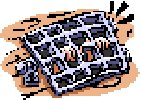
foreword | Historical Narratives | Resources | Links | Contact
NATHANIEL PETTIT
[b.1724 - d.1803]
History is the rigorous search for truth.
At 68 years of age, Nathaniel Pettit was the oldest of the province's founding brothers. Elected to the first Legislative Assembly on August 27th, 1792, he represented the riding of Durham, York and 1st Lincoln. He was one of four members serving Lincoln County, a large riding with an exceptionally complex history. Chronicles for this period are few and fragmentary, and information on Pettit's legislative record is sparse.
Nathaniel Pettit was born in Sussex County, New Jersey, in 1724. By the time of the American Revolution, he had achieved financial and social success and was a prominent member of his community. He was a judge in the Court of Common Pleas and an elected member of the legislature. In the early stages of the strife, Pettit was sympathetic to the colonial grievances and served on a committee to oppose taxation without representation. When he failed to pay the taxes levied by the revolutionary congress, he was fined and stripped of his appointments.
 |
Taxation and this treatment hastened his open declaration of support for his sovereign. Because he was "lame and infirm," Pettit was unable to join a Loyalists corps, but he contributed to the cause in other ways. When asked by the British military "to summon the inhabitants of Sussex and enroll a battalion of 500 men who were young, healthy and strong," he did so successfully. The rapid response to his call for the king also served to prove the loyalty of the citizens of Sussex.
Pettit's support for the sovereign exposed him to the savage treatment from the rebels and led to his imprisonment for over a year.
 |
Released only after he paid a heavy fine, Pettit fled from the rebellion which caused him much "grief and vexation." His property losses in New Jersey were extensive. He was obliged to sell his lands and his mills at ruinous prices, the loss "moderately" estimated by him to be 1000 pounds. Although he vigorously pressed his "well attested case for compensation before the Loyalist Claims Commission," his efforts "were attended with no effect." In 1787 he arrived in Canada
In his own words
"to solicit a settlement where he could enjoy that Liberty and comfort so amply secured by the British constitution."
Pettit petitioned for a grant of 2000 acres in Upper Canada and justified this request by citing Lord Dorchester's recognition of his services to the settlement. Despite Dorchester's highly significant support, approval was not forthcoming. Instead the Executive Council courteously informed Pettit that "The Council would feel themselves extremely happy could they comply with the prayer of the petition, but are pleased to order that he shall have a grant of 1200 acres." Pettit subsequently received another grant of land, the combined total of 2000 acres being largely located in the Saltfleet, Ancaster and the Grimsby areas.
Pettit's pre-revolutionary prominence resulted in him being appointed to the land board for Lincoln County which settled property titles throughout the great tract of land in the Niagara Peninsula that had only recently been purchased from the Aborigines. Pettit was also named to the District's first `Heir and Devisee' commission whose function was to settle Loyalist land clams. The loyalty and character of all persons claiming a land grant were closely examined by the land board. When approved the oath of allegiance was administered and the surveyor directed by the Board to issue a `ticket' to the land allotted. One such ticket was granted to David Palmer of Grimsby, whom Pettit personally certified as having "the character of an honest man who supported his large family with industry." Palmer had "great assistance" in the late war to recruits of the British arm for which Palmer and his family received 600 acres.
Pettit, who was appointed to a judgeship of the Court of Common Pleas, became known throughout the region as Judge Pettit. However, his attendance at sessions of the various courts and commissions was sporadic. His stature was best reflected by Lord Dorchester's recommendation that he be appointed to the Legislative Council. Nevertheless, Governor Simcoe rejected the recommendation, possibly because of Pettit's age but more likely because Dorchester had recommended it.
Judge Pettit died in 1803 in Ancaster. He did not live long enough to accumulate much more land than he had been granted, a substantial part of which he sold off. He left the remainder to his five surviving daughters. He never did regain in Canada the prestige nor the prominence he had known in New Jersey. Nathaniel had indicated to his daughter, Rachel, where he wished to be buried and she informed her sister that his wish had been carried out.
In Her Own Words
"He expressed a desire to be buried at The Forty (Grimsby) which in gratitude to such a dear father we willingly complied. His remains were decently buried in the first burying ground west of The Forty creek near the lake on his property, in the presence of a vast number of his friends, who all seemed to mourn the general loss."
Mrs. John Graves Simcoe visited that area with 'the Governor' on a number of occasions and left this description of the spot so loved by Pettit.
In Her Own Words
"We coasted to the Forty Mile Creek, forty miles from Niagara. The mouth of the creek forms a fine scene, a very bold spur of high land appears beautiful in the distance. Some cottages are prettily placed on the banks of the river covered from top to bottom with hemlock, pine, cedars, and other forest trees all of immense height."
 |
The duc de Rochefoucauld was also attracted to the scenic site which he visited in 1795.
In His Own Words
"Forty-Mile Creek was one of the chief objects of our tour. This stream which intersects in a straight line the range of mountains extending from Queens' Town (Queenston), flows with a gentle fall into the plain and affords some wild, awful yet very pleasing prospects among the mountains. Before it empties itself into the lake it turns a grist mill and two saw-mills."
The exact location of Pettit's grave has never been confirmed, but several years ago during the construction of high rises along the lake shore in the general vicinity of his burial site, the bones of one individual were discovered. It is believed by some members of the local historical society that they were the remains of Nathaniel Pettit.
Copyright © 2013 Website Administrator